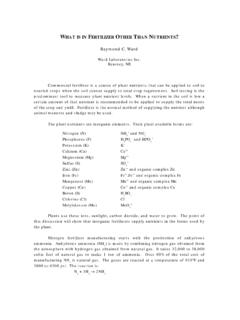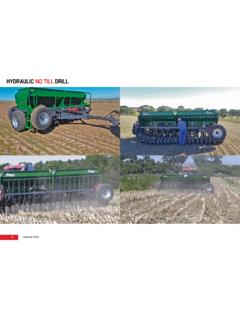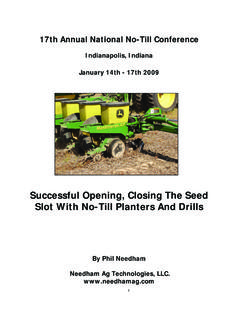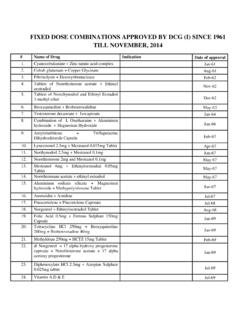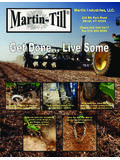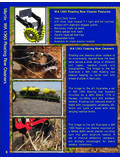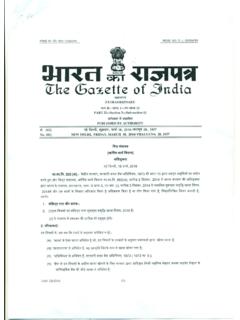Transcription of Benefits of Cover Crops in No-till Wheat Stubble
1 FIELD FACTS. Benefits of Cover Crops in No-till Wheat Stubble Curt Hoffbeck, Pioneer Area Agronomist and Jim Ruhland, Pioneer Account Manager Jason Miller, USDA NRCS Conservation Agronomist and James Millar, USDA NRCS Soil Scientist infiltration. In central South Dakota, Cover Crops would fit in Summary the time period between winter Wheat harvest and the planting of corn, sunflower or grain sorghum. Even in Use of Cover Crops has Benefits for both the soil and the central South Dakota, enough moisture is historically subsequent crop. Some of the main Benefits of Cover received to enable a Cover crop to meet one or more of your Crops in No-till Wheat Stubble are: objectives for planting it. - Brassica Cover Crops like radishes, turnips, canola, and rape help increase microbial activity and degradation of excess Wheat residue, resulting in warmer and drier seedbeds in the spring for corn planting.
2 - Many Cover Crops reduce soil compaction and improve soil structure to enhance water infiltration in No-till systems. This allows corn to be planted with less excess moisture on the field surface. - Recycling nutrients and preventing N leaching - Reclaiming saline soils for crop productivity - Providing nitrogen if a legume Cover crop is used No one Cover crop can accomplish all field objectives, so a mixture of various Cover Crops is commonly used. Most Cover Crops are drilled (preferred) or broadcast- seeded into standing Wheat Stubble in late July or during August in South Dakota. Try to select a Cover crop species (or the majority of a Cover crop mix) that is an opposite crop type to next year's cash crop. A good example is a broadleaf Cover crop planted prior to a corn crop.
3 Select appropriate residual herbicides to precede your Cover Crops . Brassicas can be very sensitive to carryover of some residual herbicides, especially Wheat herbicides. Contact your NRCS office to see if you can qualify for EQIP programs to aid you in planting your Cover Crops . Figure 1. Some common Cover Crops . Top: turnip, radish, Introduction winter canola, and sugar beet. Bottom: a Cover crop mix- A Cover crop is simply defined as any crop that is planted ture of oats, turnips, radishes, lentils, and rape growing in between periods of regular crop production. Cover Crops Wheat Stubble . September 27, 2007 - Gettysburg, SD. help prevent soil erosion, increase organic matter, provide Top picture courtesy of James Millar, NRCS; bottom picture supplemental grazing opportunities, recycle nutrients, fix courtesy of Jason Miller, NRCS Agronomist.
4 Atmospheric nitrogen, reduce compaction, and improve water FIELD FACTS VOL. 8 NO. 13 PAGE 1 PIONEER AGRONOMY SCIENCES. , TM, SM. Trademarks and service marks of Pioneer Hi-Bred International, Inc. 2008, PHII. Common Objectives for Planting Cover Crops Table 1. Cover crop objective and appropriate crop species. Before selecting a Cover crop species, growers should Objective Primary Cover Crop Species clearly identify their objectives for growing the crop. This could include one or many of the possible objectives listed Grazing turnips, lentils, rape, radish, rye, oat, below: triticale, sorghum-sudan Provide nitrogen For this purpose, include a legume crop. Reducing radish, canola, sugarbeet, sunflower, Compaction sorghum-sudan, turnip (and hybrids).
5 Addition of organic matter This is key to improving overall soil health. Moisture rape, clovers, winter Wheat , rye, triticale Improve soil structure This will enhance water infiltration and decrease water runoff. N-fixation clovers, vetches, lentils, cowpeas, soybean, field pea, chickling vetch Reduce soil erosion Saving the topsoil will enhance Residue Cycling Brassicas (canola, rape, radishes, overall soil productivity. turnips, and mustards). Reduce soil compaction Some Cover crop species Nutrient Cycling sunflower, sugarbeets, brassicas, contain excellent tap roots that will help alleviate soil small grains compaction. Salinity sugarbeets, barley, winter canola, Increase residue cycling Brassica Cover Crops such as rape canola, rape, turnips, radishes, and mustards accelerate the breakdown of residue such as Wheat Stubble .
6 This can help reduce C:N ratios of residue in the soil and allow for Table 2. Cool- and warm-season Cover crop options. a warmer and drier seedbed for earlier planting of corn the following spring. Cover Crop Options Manage nutrients A number of Cover crop species Cool Season Warm Cool Season Warm will utilize nutrients (especially nitrogen) that would Broadleaves Season Grasses Season otherwise be lost to leaching or soil erosion before the Broadleaves Grasses next cash' crop could capture them. Provide weed control A Cover crop canopy growing in Alfalfa* Cowpeas* Barley Grain and Soybeans* Oats forage sorghum the field will provide competition against weeds. Clover (red, sweet, alsike, Sunflower Spring Wheat / Sudangrass Provide livestock grazing/forage Most if not all Cover white)* Rye crop species can be utilized for livestock grazing.
7 Millet Vetch (hairy, Winter Wheat /. common, Teff grass Reduce soil salinity Cover Crops will utilize any extra Rye chickling)*. moisture that is received, which reduces the potential for Spring / Winter soil salinity problems. Winter Canola / Triticale Rape Increase crop and soil organism diversity One of the Tall Wheatgrass Lentils (red berry less appreciated soil Benefits of Cover Crops is an in- Annual Oregon or Indianhead)*. crease in the total number and diversity of soil organisms. Ryegrass Diversity is the key to a healthy, well-functioning soil. Radishes (fodder, oilseed). Enhances Wildlife Habitat Both Cover and habitat Turnips diversity are important for area wildlife. Sugar beets Crambe Because a single wonder crop is unlikely to address all of Field Peas*.
8 These objectives, a mixture or cocktail should be considered to meet multiple Cover crop objectives. The Flax following tables identify plant species that can be used to Camelina achieve various Cover crop objectives (Table 1) and cool and warm season Cover crop options (Table 2). * Legume species that can fix atmospheric nitrogen FIELD FACTS VOL. 8 NO. 13 PAGE 2 PIONEER AGRONOMY SCIENCES. , TM, SM. Trademarks and service marks of Pioneer Hi-Bred International, Inc. 2008, PHII. the success of these farming operations. This is especially true at the record high commodity prices seen recently for most Crops . Some growers have been able to address these issues in no- till Wheat Stubble by planting brassica Cover Crops like turnips, radishes, canola, rape, and mustard.
9 These brassica Cover Crops have helped increase the rate of microbial activity and decomposition of Wheat straw residue as shown in Figure 3, resulting in faster residue cycling as well as warmer and drier soils during spring corn planting. Figure 2. Side-by-side comparisons showing corn planted into Wheat Stubble that had no Cover crop planted vs. corn planted into Wheat Stubble with a previous Cover crop planted. Pictures courtesy of Jason Millar, NRCS, taken on July 9, 2008. near Gettysburg, SD. Figure 3. Winter Wheat Stubble with no Cover crop (top) vs. The Benefits of Cover Crops Planted into winter Wheat Stubble that has brassica Cover Crops planted Wheat Stubble for Spring Corn Planting into it the previous year prior to the corn crop (bottom).
10 Pictures courtesy of Jason Miller, NRCS Agronomist on July 9, Some of the major challenges in trying to plant corn into the 2008 at the SDSU Dakota Lakes Research Farm Pierre, SD. previous year's Wheat Stubble are waiting for the No-till seedbed to be warm and dry enough to plant and trying to reduce the harmful effects often associated with sidewall Winter Cover Crops with large taproots (like many of the compaction. Wheat straw can cause serious complications brassicas) can also alleviate the effects of soil compaction by for stand establishment and uniform emergence of corn penetrating the compacted layer when the soil is wet and (Figure 2, top), especially when residue levels are high. relatively soft during the winter. These Crops leave channels Also, many growers in South Dakota are farming larger and that enable water, air and cash crop roots to penetrate the larger acreages.
